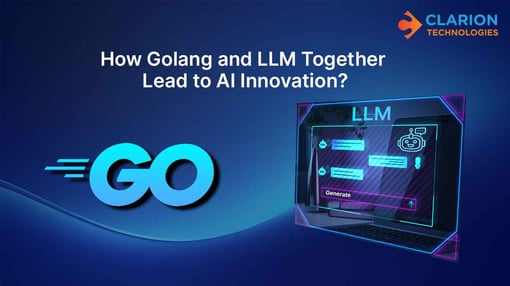Businesses are prioritizing the use of AI to create faster, better, and more scalable solutions. Among these, Golang and LLMs are the most popular. Golang is well known for its speed and scalability and about 93 percent of developers prefer it (TMS).
LLM is known for its advanced data processing capabilities. As per Hostinger, 67% of businesses use it worldwide to utilize its data processing capabilities.
In case you’re curious about using the combination of the Go LLM framework, we’re here to help you with that. Read our blog to understand the main reasons why you can use these technologies for better outcomes.
Reasons to Consider Golang and LLM
To understand why Golang AI technology and LLM technology are a powerful combination, let’s first break down each of them to examine their benefits.
The Power of Golang
Golang or Go, is a statically typed compiled programming language created by Google. Its main strengths lie in its performance, easy usage, and concurrency capabilities. It helps in maintaining the system’s effectiveness to expand business and handle more data.
According to Go.dev, 93 percent of developers reported that Golang’s performance significantly reduces infrastructure costs. Let’s understand more about why you should consider Golang:
- It is a great option for AI applications that must process a lot of data faster.
- It can manage several activities at once without compromising performance with its lightweight design and effective concurrency architecture.
- Golang development services are well-suited for applications such as real-time AI data processing.
The Rise of LLMs
LLMs such as OpenAI's GPT-3, GPT-4, or Google’s BERT, represent the cutting edge of AI and NLP. These models are trained on vast amounts of data to comprehend and generate human-like text. They’re extremely effective tools for automating tasks like content generation, customer service, and advanced decision-making.
According to McKinsey, businesses that use AI-powered tools like chatbots and automated content generation systems can save up to 30 percent cost savings in customer service. Let’s deep dive into why you should consider LLM development services:
- It can process and understand complex language patterns and bring real-time outputs.
- Businesses can develop AI solutions that respond intelligently to customer queries and automate tedious workflows.
- This automation can help businesses achieve operational efficiency and improve client experiences.
You understand why these technologies are crucial. However, it’s equally important to know how you can combine Golang for AI with LLM to get the most out of it to grow your business.
Ways Golang and LLMs Together Drive AI Innovation
While each of these technologies can be powerful on its own, their true potential gets multiplied when used together. Let’s examine how both work together to drive AI innovation and help businesses stay ahead.
Scalable Infrastructure for High-Performance AI
Golang is perfect for creating scalable infrastructure that can manage a large volume of AI requests. LLMs are resource-heavy models that need a lot of processing power to produce results quickly. When combined, both can work smoothly.
For example, Assembled, a customer service platform, integrated Golang to handle millions of LLM requests each month. Their Go-based infrastructure uses interfaces to build composable response pipelines.
How did it help?
- Ensured minimal performance
- Maintained high throughput
- Provided AI-driven customer support interactions
Real-Time Data Processing and Low Latency
Combining both technologies enables businesses to process data in real-time and provide immediate insights and responses. This integration is crucial for applications in sectors like eCommerce, banking and healthcare, where quick information is crucial.
Wispr Flow, a software company that uses AI to provide voice dictation and transcription solutions. Their applications use Go for effective backend processing, which helps in delivering real-time transcription across multiple platforms.
How did it help?
- Ensured real-time transcription
- Maintained low latency
- Provided continuous service
Cost Efficiency in AI Model Deployment
Golang’s lightweight nature reduces the overhead involved with implementing AI models, resulting in lower infrastructure and maintenance costs. It is helpful for businesses and startups trying to optimize their AI investments.
Just like BricksLLM, it’s a cloud-native AI gateway that offers enterprise-level infrastructure for LLM deployment. It offers features like usage limits, cost tracking and failover procedures that enable businesses to handle AI deployments.
How did it help?
- Ensured cost optimization
- Maintained scalable infrastructure
- Provided enterprise-level AI solutions
Enhanced Productivity and Ecosystem Integration
The combination of Golang and LLMs makes it easier to develop AI applications by offering reliable libraries and frameworks. This integration streamlines the development process, which helps developers focus on creating innovative solutions.
For example, Golang full-stack LLM framework is an open-source toolkit that combines various features such as speech processing, prompt management, LLM interaction, and Retrieval-Augmented Generation (RAG). This framework helps developers in custom AI development effectively.
How did it help?
- Ensured faster development cycles
- Maintained efficient performance
- Provided flexible AI application development
Future of Golang and LLM with AI
As we look ahead, the outlook for both Go and LLMs in AI is quite promising. Both technologies are developing and opening up new possibilities for organizations. Let’s get into what you can expect in the future:
Golang is already widely used by companies building scalable services. As of 2025, 9,200+ businesses have confirmed implementing Go across different industries (Landbase). Hiring Golang developers will give your business an architectural advantage and place your infrastructure in a state where the next wave of AI deployments becomes possible.
LLMs have become business-critical. The enterprise market for LLMs is expanding fast, and their uses are getting more diverse, ranging from analytics to automation to customer interfaces. As per Business Research, the LLM market size is all set to grow to over USD 24.89 billion by 2029. This implies that:
- LLMs are becoming essential for core operational tools.
- Businesses can have an increase in productivity, offer more individualized services, and be ready for the future wave of AI-driven processes.
Let Clarion Implement Golang and LLM with AI
Golang’s scalability and efficiency make it ideal for integrating with Large Language Models (LLMs). This pairing enables businesses to build high-performance apps that can manage large data volumes while maintaining the best possible memory management.
With Golang and LLMs, businesses can accelerate development timelines. This combination helps to meet the demands of modern AI solutions with natural language understanding.
Partnering with an experienced Golang development service provider like Clarion Technologies can provide the expertise required to implement LLM-based solutions and future-proof your infrastructure. Our team of A-Players works diligently to achieve your business goals. Contact us to hire Golang developers in India and to know more about how our AI-driven Go LLM services can transform your business results.
Author







